Toward Sustainable Brownfield Redevelopment Using Life-Cycle Thinking
Abstract
:1. Introduction
2. Materials and Methods
2.1. Establishing the Management Procedure for Brownfield Redevelopment
2.2. Sustainable Assessment Indicators and Schematic Diagram of Brownfield Redevelopment
2.3. Establishment of the Brownfield Sustainability Index (BSI)
(a) Net external benefits
(b) Net economic benefits
3. Results
4. Discussion
5. Conclusions
Acknowledgments
Author Contributions
Conflicts of Interest
Abbreviations
| BSI | Brownfield sustainability index |
| NPL | National priorities list |
| GAO | General accounting office |
| SGPRA | Soil and groundwater pollution remediation action |
| TWEPA | Taiwan EPA |
| HRS | Hazard ranking system |
| NPV | Net present value |
| IRIS | Integrated risk information system |
| LCT | Life-cycle thinking |
References
- Gertler, M. Adapting to New Realities: Industrial Land Outlook for Metropolitan Toronto, Durham, York, Halton, Peel, Hamilton-Wentworth and Waterloo; Berridge Lewinberg Greenberg Dark Gabor Ltd.: Toronto, ON, Canada, 1995. [Google Scholar]
- Alker, S.; Joy, V.; Roberts, P.; Smith, N. The definition of brownfield. J. Environ. Plan. Manag. 2000, 43, 49–69. [Google Scholar] [CrossRef]
- De Sousa, C. Contaminated sites: The Canadian situation in an international context. J. Environ. Manag. 2001, 62, 131–154. [Google Scholar] [CrossRef]
- US Environmental Protection Agency (USEPA). The New Brownfields Law; US Environmental Protection Agency: Washington, DC, USA, 2002.
- Page, G.W.; Berger, R.S. Characteristics and land use of contaminated brownfield properties in voluntary cleanup agreement programs. Land Use Policy 2006, 23, 551–559. [Google Scholar] [CrossRef]
- Oliver, L.; Ferber, U.; Grimski, D.; Millar, K.; Nathanail, P. The scale and nature of European brownfields. In Proceedings of the CABERNET 2005-International Conference on Managing Urban Land, Belfast, UK, 13–15 April 2005; LQM Ltd.: Nottingham, UK, 2007. [Google Scholar]
- US Environmental Protection Agency (USEPA). Brownfields Definition. Available online: https://www.epa.gov/brownfields/brownfield-overview-and-definition (accessed on 28 September 2016).
- US Environmental Protection Agency (USEPA). Brownfields Road Map to Understanding Options for Site Investigation and Cleanup, 5th ed.BiblioGov: Washington, DC, USA, 2012.
- Chen, D.S. City of Plutocracy: A Social Analysis on Local Factions, Plutocrats and the Urban Development in Taipei; ChuLiu: Taipei, Taiwan, 1995. (In Chinese) [Google Scholar]
- Contaminated Land Rehabilitation Network for Environmental Technologies (CLARINET). Brownfields and Redevelopment of Urban Areas; Umweltbundesamt GmbH (Federal Environment Agency Ltd): Wien, Austria, 2002. [Google Scholar]
- Contaminated Land Rehabilitation Network for Environmental Technologies (CLARINET). Review of Decision Support Tools for Contaminated Land Management, and Their Use in Europe; Umweltbundesamt GmbH (Federal Environment Agency Ltd): Wien, Austria, 2002. [Google Scholar]
- Taiwan Environmental Protection Administration (TWEPA). Soil and Groundwater Pollution Remediation Act. Available online: http://law.moj.gov.tw/Eng/LawClass/LawAll.aspx?PCode=O0110001 (accessed on 28 September 2016).
- US Environmental Protection Agency (USEPA). Using the Triad Approach to Streamline Brownfields Site Assessment and Cleanup—Brownfields Technology Primer Series; US Environmental Protection Agency: Washington, DC, USA, 2003.
- US Environmental Protection Agency (USEPA). Summary of the Small Business Liability Relief and Brownfields Revitalization Act; US Environmental Protection Agency: Washington, DC, USA, 2002.
- De Sousa, C.A. The Brownfield Problem in Urban Canada Issues, Approaches and Solutions (Ontario). Ph.D. Thesis, University of Toronto, Toronto, ON, Canada, 2000. [Google Scholar]
- Adams, D.; De Sousa, C.; Tiesdell, S. Brownfield development: A comparison of North American and British approaches. Urban Stud. 2010, 47, 75–104. [Google Scholar] [CrossRef]
- Otsuka, N.; Dixon, T.; Abe, H. Stock measurement and regeneration policy approaches to ‘hardcore’ brownfield sites: England and Japan compared. Land Use Policy 2013, 33, 36–41. [Google Scholar] [CrossRef]
- Meyer, P.B.; Lyons, T.S. Lessons from private sector brownfield redevelopers—Planning public support for urban regeneration. J. Am. Plan. Assoc. 2000, 66, 46–57. [Google Scholar] [CrossRef]
- Bagaeen, S.B. Redeveloping former military sites: Competitiveness, urban sustainability and public participation. Cities 2006, 23, 339–352. [Google Scholar] [CrossRef]
- Thornton, G.; Franz, M.; Edwards, D.; Pahlen, G.; Nathanail, P. The challenge of sustainability: Incentives for brownfield regeneration in Europe. Environ. Sci. Policy 2007, 10, 116–134. [Google Scholar] [CrossRef]
- Wernstedt, K.; Hersh, R. Urban land use and superfund cleanups. J. Urban Aff. 1998, 20, 459–474. [Google Scholar] [CrossRef]
- De Sousa, C.A. Brownfield redevelopment in Toronto: An examination of past trends and future prospects. Land Use Policy 2002, 19, 297–309. [Google Scholar] [CrossRef]
- Lee, S.; Mohai, P. Environmental justice implications of brownfield redevelopment in the United States. Soc. Natl. Res. 2012, 25, 602–609. [Google Scholar] [CrossRef]
- Tang, Y.T.; Nathanail, P.C. Sticks and Stones: The impact of the definitions of brownfield in policies on socio-economic sustainability. Sustainability 2012, 4, 840–862. [Google Scholar] [CrossRef]
- Hula, R.C.; Bromley-Trujillo, R. Cleaning up the mess: Redevelopment of urban brownfields. Econ. Dev. Q. 2010, 24, 276–287. [Google Scholar] [CrossRef]
- Ferber, U.; Grimski, D.; Millar, K.; Nathanail, P. Sustainable Brownfield Regeneration: CABERNET Network Report 2006; University of Nottingham: Nottingham, UK, 2006. [Google Scholar]
- World Bank. The Management of Brownfields Redevelopment; World Bank: Washington, DC, USA, 2010. [Google Scholar]
- Vermeer, N.; Vermeulen, W. External benefits of brownfield redevelopment: An applied urban general equilibrium analysis. J. Benefit-Cost Anal. 2012, 3, 1–33. [Google Scholar] [CrossRef]
- Thomas, M.R. A gis-based decision support system for brownfield redevelopment. Lands. Urban Plan. 2002, 58, 7–23. [Google Scholar] [CrossRef]
- GSG Consultants, Inc. Smart Growth for Brownfields Redevelopment; GSG Consultants, Inc.: Chicago, IL, USA, 2005. [Google Scholar]
- Cheng, F.; Geertman, S.; Kuffer, M.; Zha, Q. An integrative methodology to improve brownfield redevelopment planning in Chinese cities: A case study of Futian, Shenzhen. Sustain. Urban Dev. 2011, 35, 388–398. [Google Scholar] [CrossRef]
- Byrne, J. Policy Science and the Administrative State: The Political Economy of Cost-Benefit Analysis in Confronting Values in Policy Analysis; Sage publications: Newbury Park, CA, USA, 1999. [Google Scholar]
- Alberini, A.; Longo, A.; Tonin, S.; Trombetta, F.; Turvani, M. The role of liability, regulation and economic incentives in brownfield remediation and redevelopment: Evidence from surveys of developers. Reg. Sci. Urban Econ. 2005, 35, 327–351. [Google Scholar] [CrossRef]
- Finnamore, J. Modelling the financial risks of remediation. In NATO/CCMS Pilot Study; North Atlantic Treaty Organization’s Committee on the Challenges of Modern Society (NATO/CCMS): Wiesbaden, Germany, 2000; pp. 83–91. [Google Scholar]
- Wedding, G.C.; Crawford-Brown, D. Measuring site-level success in brownfield redevelopments: A focus on sustainability and green building. Environ. Manag. 2007, 85, 483–495. [Google Scholar] [CrossRef] [PubMed]
- Chen, I.-C.; Ma, H.-W. Using risk maps to link land value damage and risk as basis of flexible risk management for brownfield redevelopment. Chemosphere 2013, 90, 2101–2108. [Google Scholar] [CrossRef] [PubMed]
- Department for Environment, Food and Rural Affairs (DEFRA). Valuation of the External Costs and Benefits to Health and Environment of Waste Management Options; Department for Environment, Food and Rural Affairs: London, UK, 2004.
- Efroymson, R.-A.; Nicolette, J.-P.; Suter, G.-W. A framework for net environmental benefit analysis for remediation or restoration of contaminated sites. Environ. Manag. 2004, 34, 315–331. [Google Scholar] [CrossRef] [PubMed]
- National Research Council. Hidden Costs of Energy: Unpriced Consequences of Energy Production and Use; National Research Council: Washington, DC, USA, 2010. [Google Scholar]
- Godin, D.; Bouchard, C.; Vanrolleghem, P.-A. Net environmental benefit: Introducing a new LCA approach on wastewater treatment systems. Water Sci. Technol. 2012, 65, 1624–1631. [Google Scholar] [CrossRef] [PubMed]
- Hertwich, E.-G.; Gibon, T.; Bouman, E.-A.; Arvesen, A.; Suh, S.; Heath, G.-A.; Bergesen, J.-D.; Ramirez, A.; Vega, M.-I.; Shi, L. Integrated life-cycle assessment of electricity-supply scenarios confirms global environmental benefit of low-carbon technologies. Proc. Natl. Acad. Sci. USA 2015, 112, 6277–6282. [Google Scholar] [CrossRef] [PubMed]
- United Nations Environment Programme (UNEP). Melbourne Principles for Sustainable Cities; International Environmental Technology Centre: Shiga, Japan, 2002. [Google Scholar]
- Taiwan Environmental Protection Administration (TWEPA). Soil and Groundwater Pollution Remediation Fee Planning Plan 2012; Taiwan Environmental Protection Administration: Taipei, Taiwan, 2012. (In Chinese)
- Lu, H.-M. Energy structure in Taiwan. Sci. Dev. 2011, 64, 60–65. [Google Scholar]
- Taiwan Environmental Protection Administration (TWEPA). Establish the Assessment Database and the Re-Development Mechanism of the Brownfields in Taiwan; Taiwan Environmental Protection Administration: Taipei, Taiwan, 2014. (In Chinese)
- Lee, Y.-L.; Huang, C.-C.; Chen, T.-G. Research on the method of stigma valuation of contaminated land in Anshun. In Proceedings of the National Symposium on Disaster Crisis Management, Taiwan, 9 May 2002; pp. 267–281. (In Chinese)
- Integrated Risk Information System (IRIS). Available online: https://cfpub.epa.gov/ncea/iris/iris_documents/documents/subst/0368_summary.pdf#nameddest=canceroral (accessed on 28 September 2016).
- Agency for Toxic Substances and Disease Registry (ATSDR). Available online: https://www.atsdr.cdc.gov/toxprofiles/tp132-c8.pdf (accessed on 28 September 2016).
- US Environmental Protection Agency (USEPA), Regional Screening Levels (RSLs). Available online: https://www.epa.gov/risk/regional-screening-levels-rsls-users-guide-may-2016 (accessed on 28 September 2016).
- US Environmental Protection Agency (USEPA). Risk Assessment Guidance for Superfund Volume I: Human Health Evaluation Manual Part B, Development of Risk-Based Remediation Goal; Office of Emergency and Remedial Response: Washington, DC, USA, 1991.
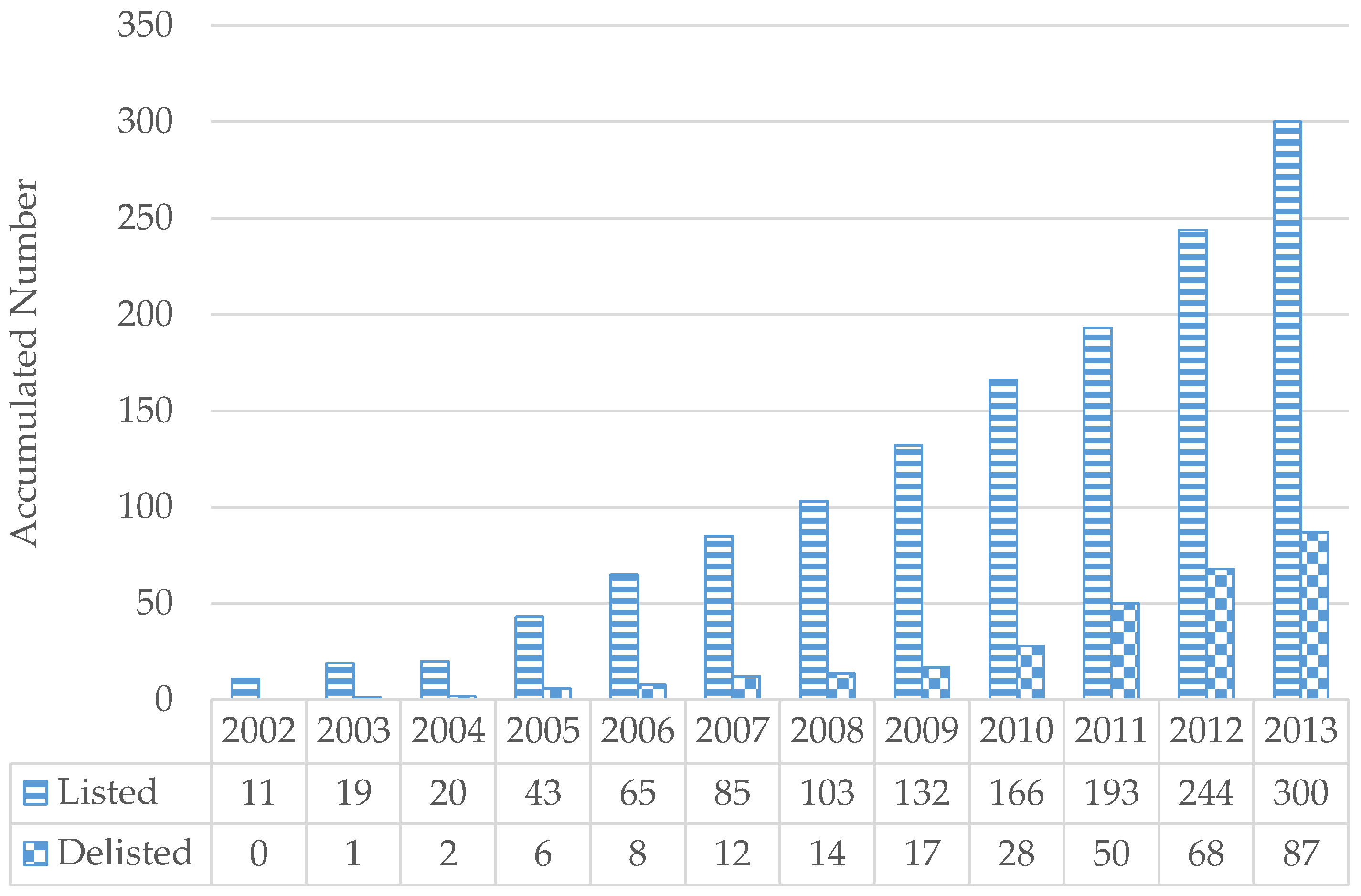
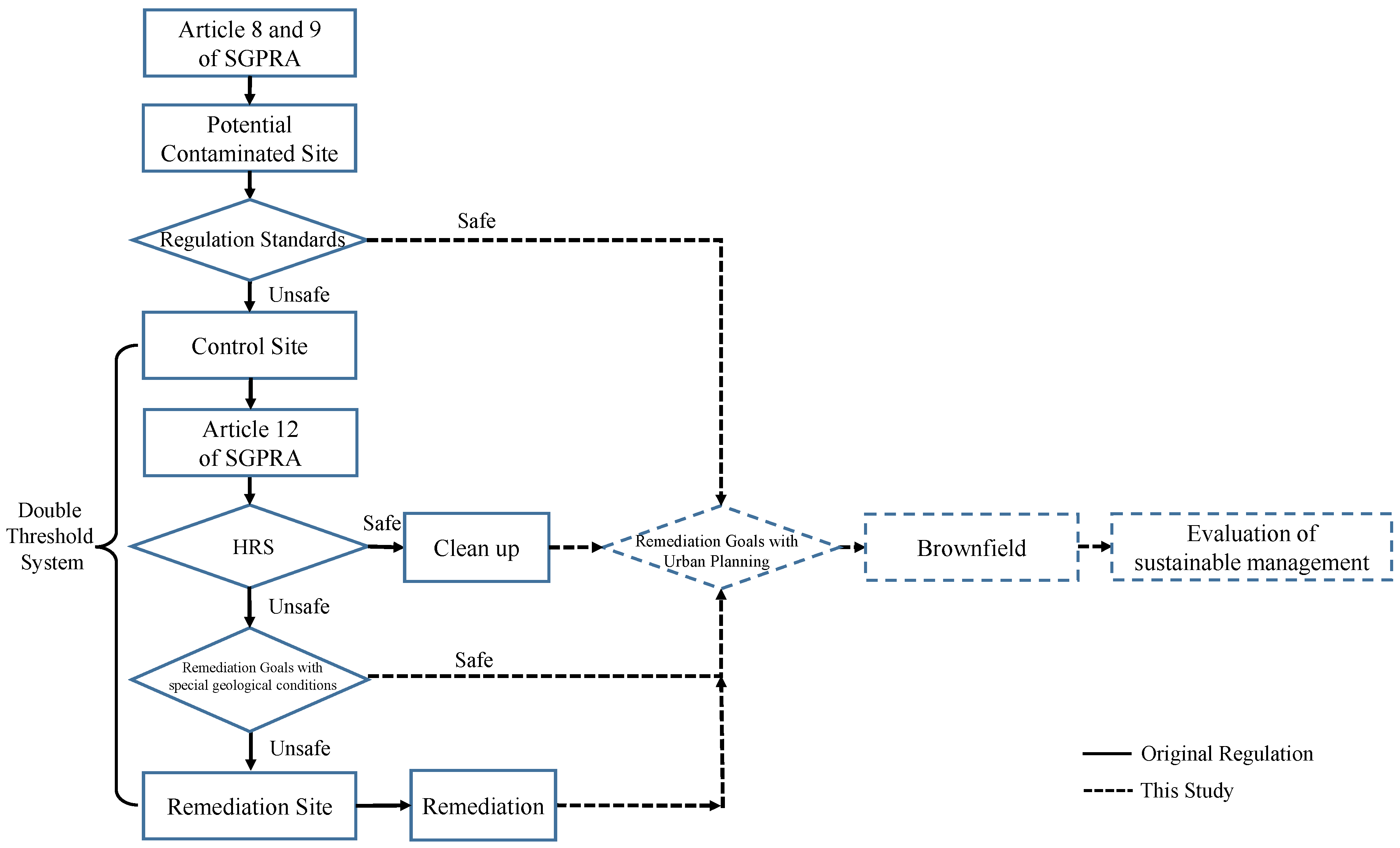
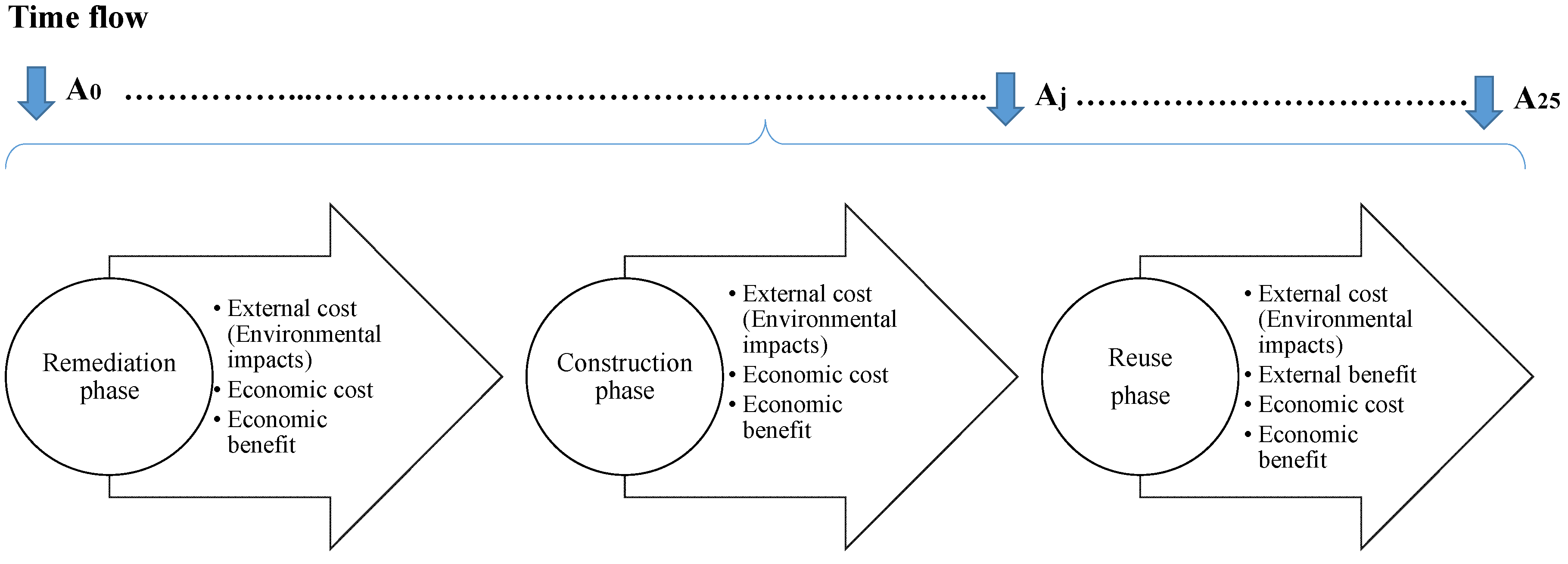
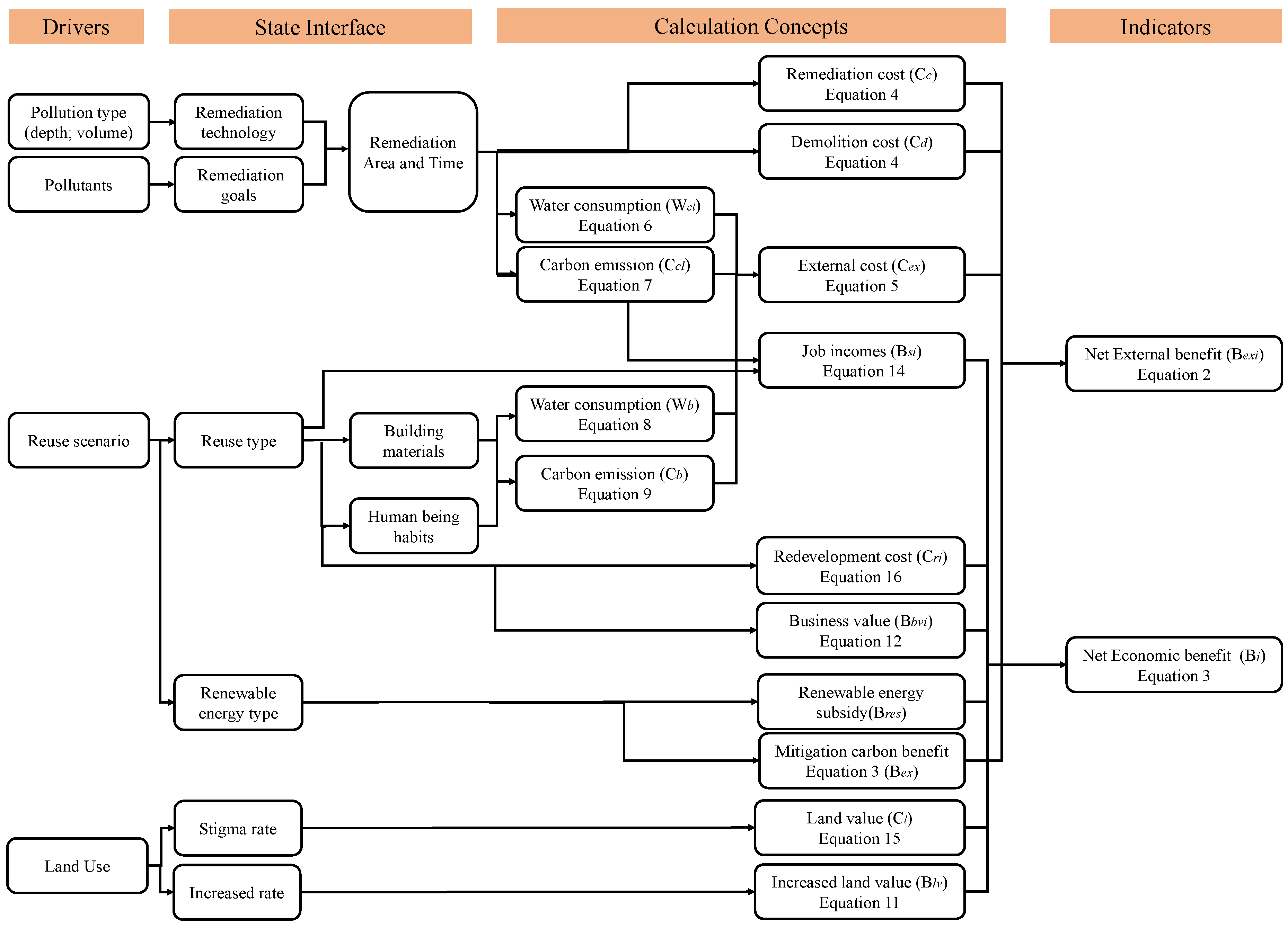
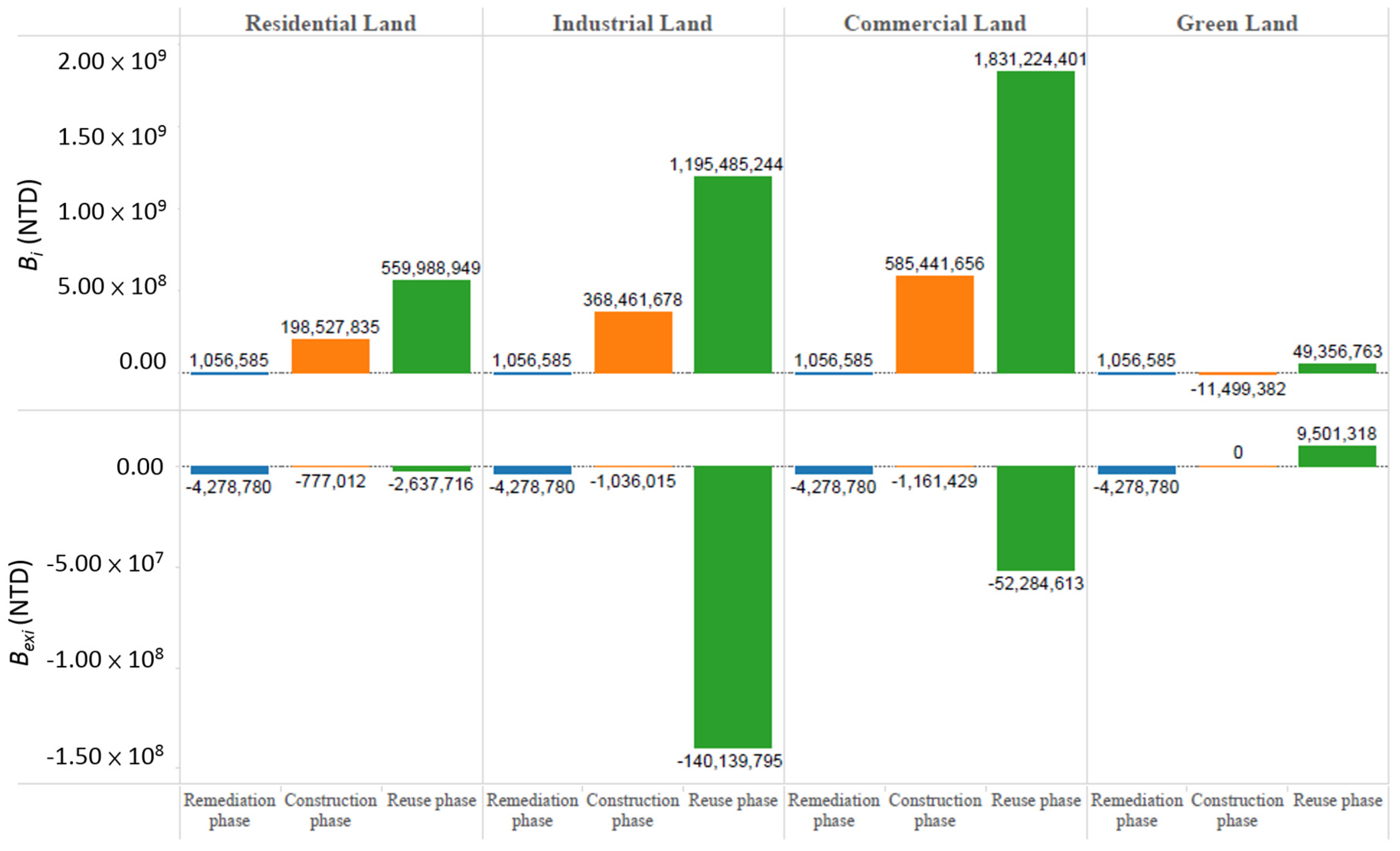
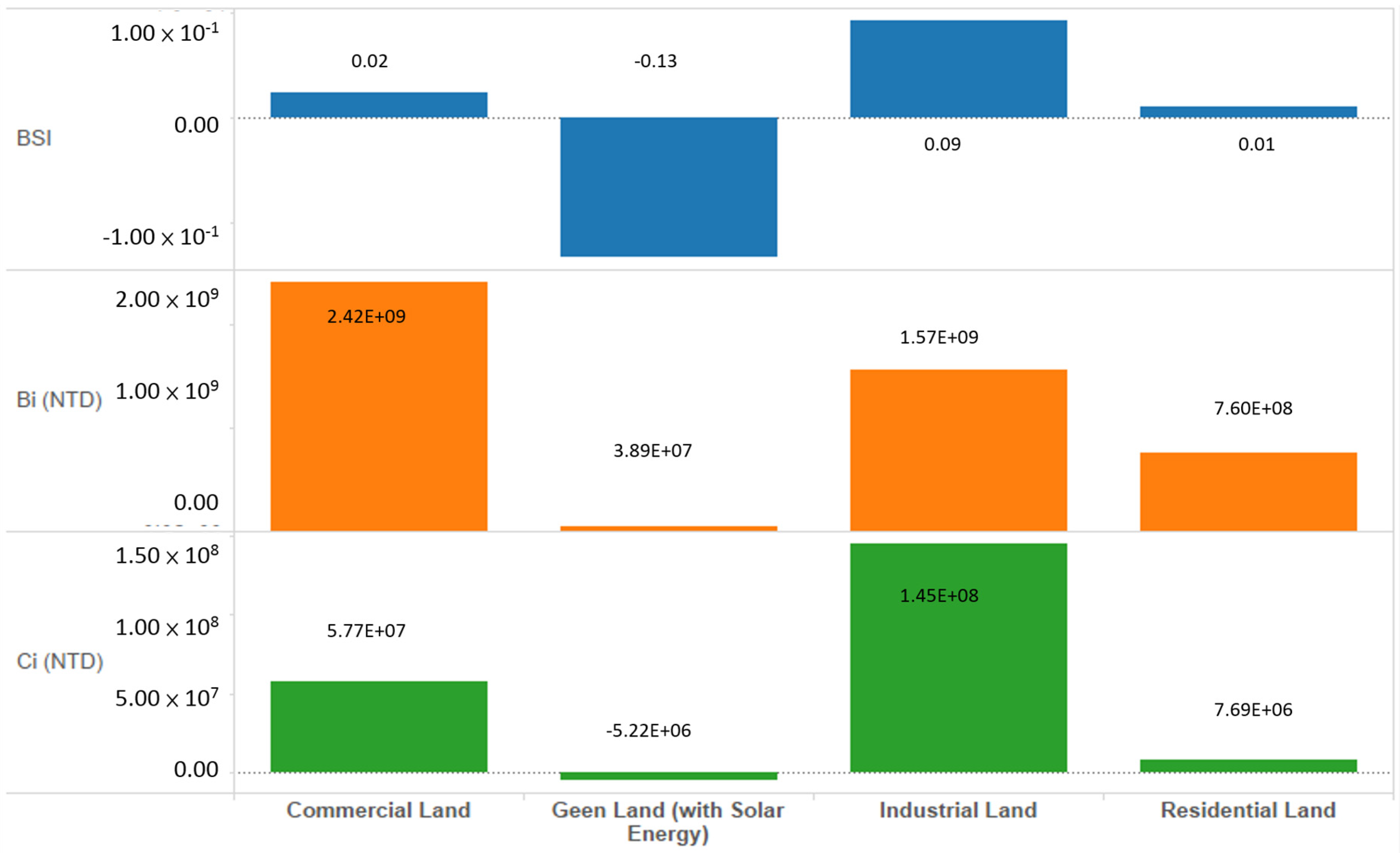
| Categories | Remediation Phase | Construction Phase | Reuse Phase |
|---|---|---|---|
| External Cost | Cleanup cost Remediation cost External cost from carbon and water emissions | External cost from carbon and water emissions from resource materials of new building Demolition cost | External cost from carbon and water emissions from human lifestyle |
| External Benefit | - | - | Mitigation benefit of renewable energy |
| Economic Cost | Land value (including stigma damage) | Building demolition cost | Redevelopment cost |
| Economic Benefit | - | - | Increased land value Business value Renewable energy subsidy |
| Social Benefit | Added employment income from remediation projects | Added employment income from construction projects | Added employment income from reuse projects |
| Industrial Category | Pollutant | Regulation Standard (mg/kg) | Remediation Goals (mg/kg) | ||
|---|---|---|---|---|---|
| Residential Land | Industrial/Commercial Land | Green Land | |||
| Electronic Components Manufacturing | Cu | 400 | 11,261.29 | 72,024.99 | 84,206.12 |
© 2016 by the authors; licensee MDPI, Basel, Switzerland. This article is an open access article distributed under the terms and conditions of the Creative Commons Attribution (CC-BY) license (http://creativecommons.org/licenses/by/4.0/).
Share and Cite
Chen, I.-C.; Tsai, Y.-C.; Ma, H.-W. Toward Sustainable Brownfield Redevelopment Using Life-Cycle Thinking. Sustainability 2016, 8, 994. https://doi.org/10.3390/su8100994
Chen I-C, Tsai Y-C, Ma H-W. Toward Sustainable Brownfield Redevelopment Using Life-Cycle Thinking. Sustainability. 2016; 8(10):994. https://doi.org/10.3390/su8100994
Chicago/Turabian StyleChen, I-Chun, Yeng-Chieh Tsai, and Hwong-Wen Ma. 2016. "Toward Sustainable Brownfield Redevelopment Using Life-Cycle Thinking" Sustainability 8, no. 10: 994. https://doi.org/10.3390/su8100994






